On the Road is a weekday feature spotlighting reader photo submissions.
From the exotic to the familiar, whether you’re traveling or in your own backyard, we would love to see the world through your eyes.
Albatrossity
This week’s photo-essay goes back a ways, both in terms of the pictures (and the quality thereof) and in terms of the history of the planet we live on. In the fall of 2003 Elizabeth and I made a trip to La Junta CO, in the high plains eastern half of that state, to see one of the remnants of when dinosaurs walked the earth, a dinosaur trackway in Picketwire Canyon. We met some friends (Elizabeth’s dissertation advisor and his wife, recently retired from Indiana University), camped on the rim of the canyon, and hiked down into the past.
Picketwire, the word and the river, has a past. Indigenous people have lived there for thousands of years; there were petroglyphs in the area near our camp site. We do not know their name for this river. The Spanish explorers, who were the first Europeans to visit this part of the continent, named the shallow river El Rio de Las Animas Perdidas en Purgatorio or the River of Souls Lost in Purgatory.
This was in memory of a 1593 expedition whose leader was murdered by other expedition members, who wanted to seek the legendary cities of gold. The killers took over leadership of the group, but the expedition was left priest-less, since the clerics with the original expedition refused to travel under the leadership of murderers. So the rogue party struck out on their own into the heart of the Comanche nation; they were surrounded by the Comanche and massacred in a canyon along this river.
Since they had no priest to perform the last rites, their souls were condemned to Purgatory for eternity, and the river was named for them. French trappers called it the Purgatoire, and even later some Texas cattlemen, who had no use for unpronounceable place names bestowed by Papist furriners, bowdlerized it to Picketwire. Progress, of a sort.
Even further back this land was the shore of a vast lake, and 150 million years ago that lakeshore was traveled by dinosaurs. Their fossilized tracks are visible today, and well worth the 5-mile hike into this roadless area.
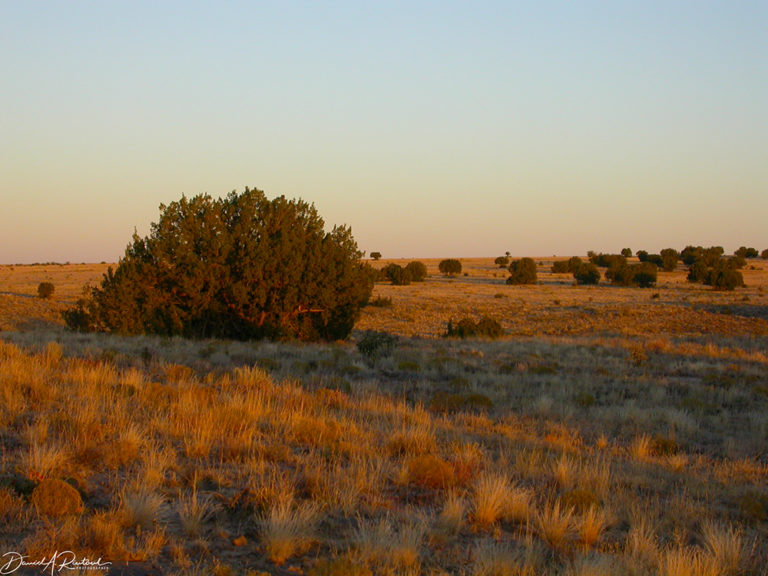
Our campsite was in Vogel Canyon, aptly enough, although vogelsong was not apparent in the late fall. So this photo-essay has no pictures of birds, other than this landscape named after the birds. And some footprints of their legendary ancestors. Here is the sunset from our campsite that evening.
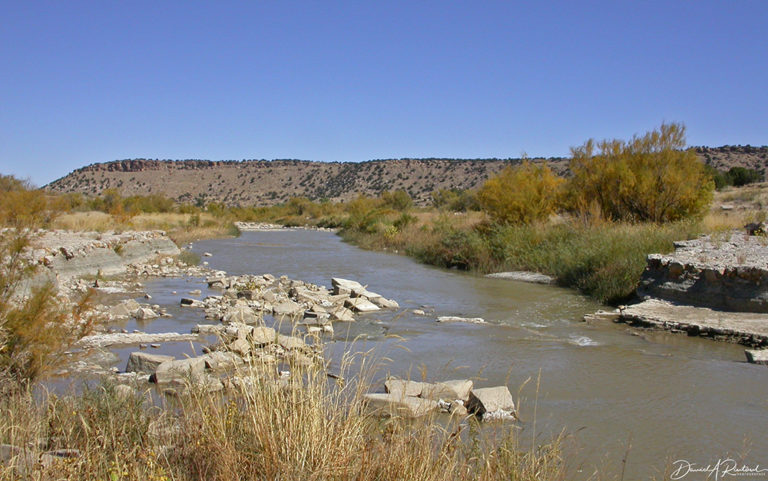
The river is not much to look at, even for this semi-desert landscape.
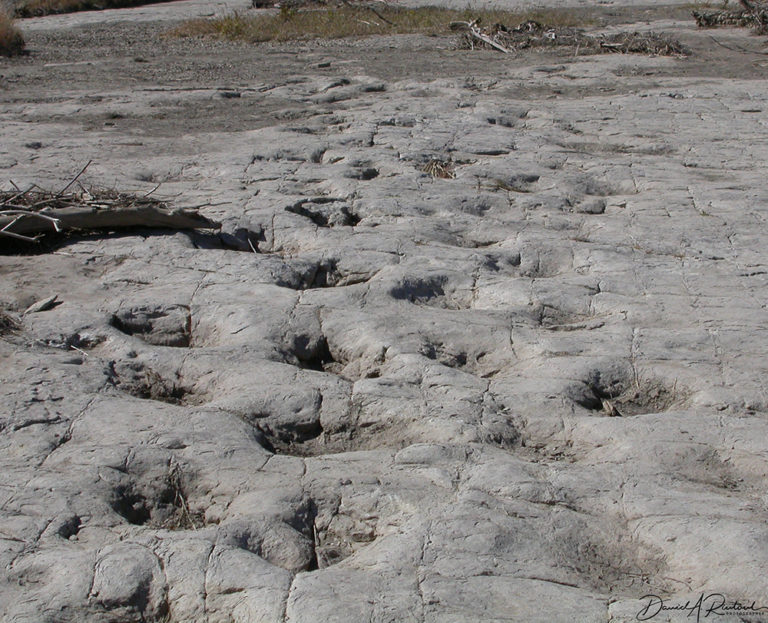
The destination was a hard-bottom crossing, where the locals used to cross with their farm wagons until a bridge was built a few miles away at the now-vanished town of Higbee. They noted the large depressions in the rocky bottom, and referred to them as “elephant tracks”. They are, of course, much larger than elephant tracks, and are the signs that large vegetarian sauropods as well as smaller carnivorous allosaurs lived here millions of years ago.
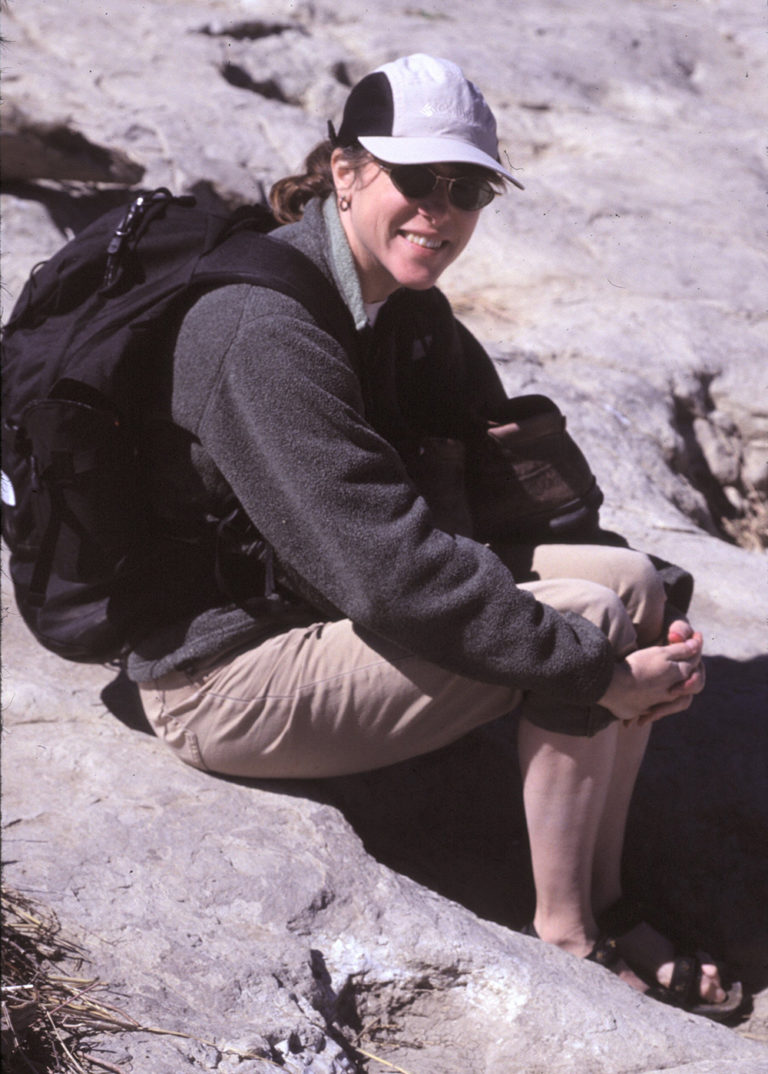
Many of the sauropod tracks were large enough that one could soak their feet in them. Sadly they contained no water, only dust. Poet and essayist included for scale.
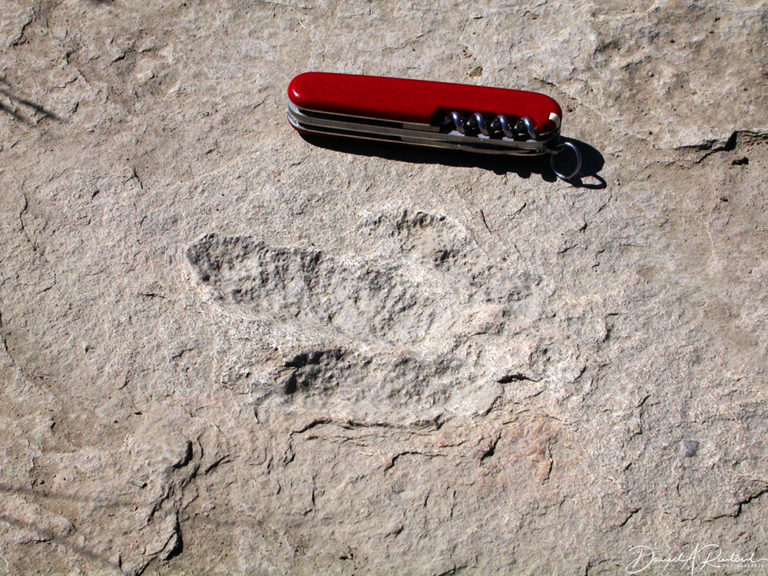
Carnivore tracks were not as common, but there were still many to see. Here’s one with the standard “Swiss Army knife for scale” unit of measurement included.
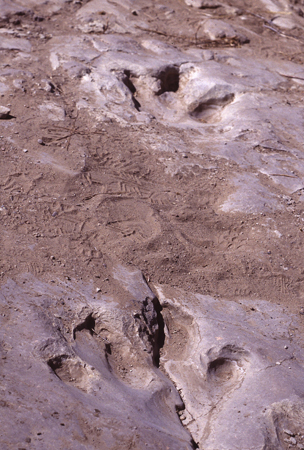
Another set of allosaur tracks.
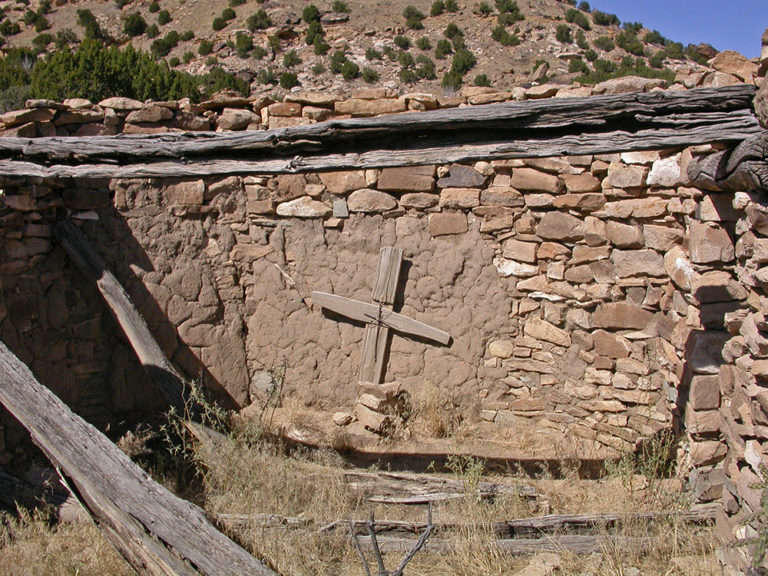
The trail into and out of the canyon also has some interesting signs of past human habitation. This is said to be a “morada”, an outpost of the religious sect known as the Penitentes. This part of Colorado was pretty much ignored by the Spanish governors and missionaries; an 1812 assessment documents that there were only 22 missionaries and 2 regular priests in an area with 102 Spanish settlements and 26 Pueblos. In the absence of higher-level religious guidance, a lay religous sect, La Fraternidad Piasoda de Nuestro Padre Jesus Nazareno (the Pious Brotherhood of Our Father Jesus of Nazareth), also known as the Penitentes, grew and flourished. The tenets of this sect included severe physical punishment, including self-flagellation and re-enactments of the Crucifixion. The established church frowned on these activities (despite encouraging them in previous centuries), but the Penitentes continued their practices, sometimes secretly, well into the latter half of the 19th Century.
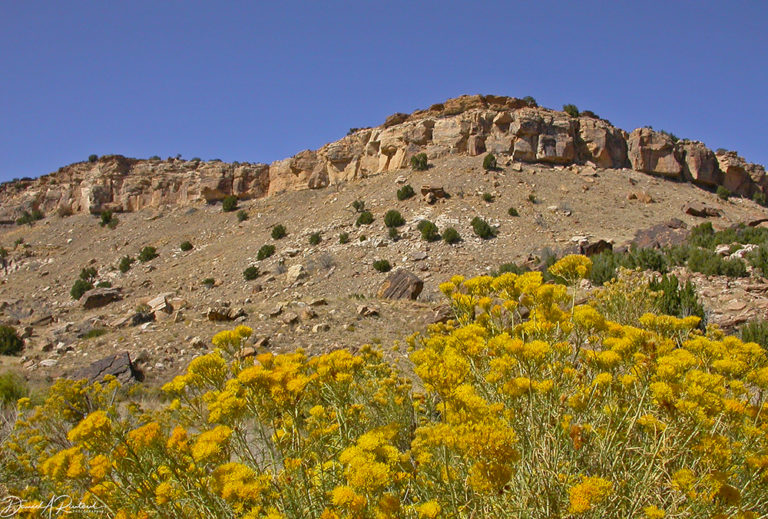
Another view of the canyon walls from the hike out.
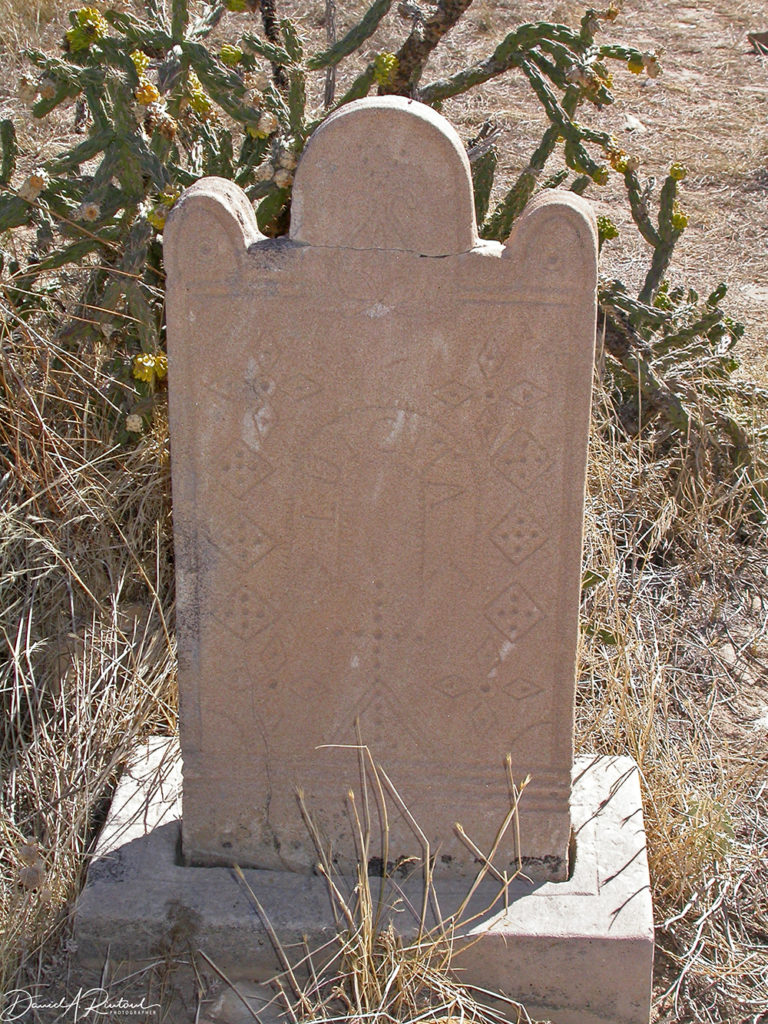
In June of the next year we went back to this area (Elizabeth was researching an essay which later appeared in the Georgia Review Vol. 59, No. 3 (FALL 2005), pp. 514-530, and was also included in her essay collection “In the Mind’s Eye“) for some additional exploring. We found the cemetery at Higbee, which contained not only a couple of headstones made of petrified wood, but also this sandstone one, which was pretty much been erased by the constant winds and sunshine that it was exposed to. Sic transit gloria mundi.
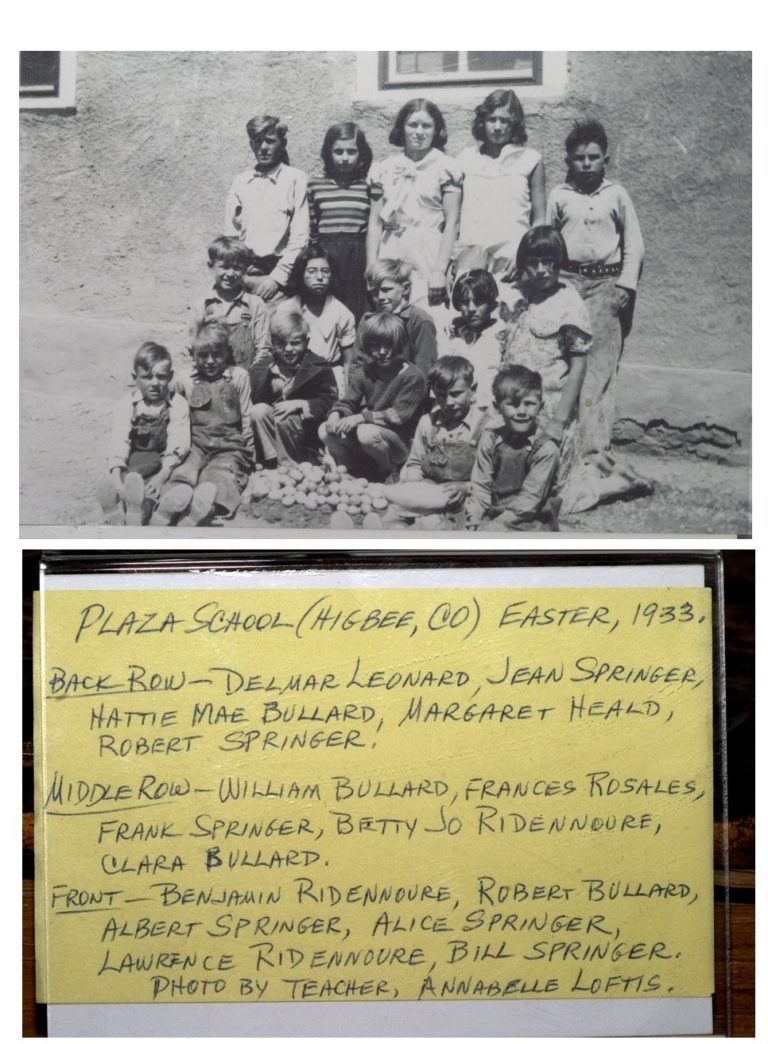
The dinosaur trackway was first brought to the public eye by a report from a local ranch girl, Betty Jo Riddenoure, who reported the elephant tracks to her teacher, and the teacher passed that along to folks who eventually got the attention of the American Museum of Natural History. R.T. Bird and John Stuart MacClary examined the site, and the pair had a tiny article in Life Magazine in 1936, showing some of the tracks. An additional article in National Geographic appeared in 1938. None of these show the original observer, Betty Jo Riddenoure, but this photo from a grade school group picture in 1933 (from the museum in La Junta) includes her, second from the right in the middle row. She was still alive and living in Arizona in 2004, and Elizabeth’s essay, mentioned above, has an account of her correspondence with Betty Jo.

OzarkHillbilly
Nothing like a Monday with Albatrossity.
Reboot
Thanks for this vast expanse of time captured–there’s something about going from the tracks to the school photo and the names underneath that really brings that home to me.
Betty
Fascinating history that doesn’t seem to be widely known.
donatellonerd
thank you.
Wag
Thank you for highlighting this little known treasure in Colorado. The Canyon has been on my bucket list for a number of years, and has definitely moved higher on the list after your essay.
Redshift
Cool!
Mark Field
The Picketwire is also famous as the location of the movie The Man Who Shot Liberty Valance.
Xavier
Higbee, Colorado in 1933 would have been very close to the heart of the Dust Bowl.
Miss Bianca
Man, I *live* in Colorado and I’ve never heard of this place!
Although I have heard of the Penitentes. There’s a Penitente Canyon over in the San Luis Valley (just west of me as the crow flies over the Sangre de Cristo mountains). The Penitentes were also active well into the 20th century and even (as far as I know) edging into the 21st Century around Pecos, NM – my late sister used to live there, and there was a Penitente lodge or shrine or something out beyond her house, we used to go walking by it all the time.
I was married from Santa Fe on Winter Solstice in 1995, and I distinctly remember something going on at the Penitente lodge around that time – they must have been in preparation for some event. My sisters and I went sneaking over there in the dark to see what we could see, and I remember feeling like I was in some particularly silly spy movie.
That being said, I knew about Dinosaur in the northwest of the state, but didn’t know about the fossilized tracks in La Junta. I will have to make a trip down that way sometime. Thank you!
mvr
This is pretty cool and very interesting! Is that the Arkansas River?
J R in WV
@mvr:
No, mvr, it’s the Picketwire River, formerly know as the Penitente River back when the Spanish were in charge of the whole SouthWest. Read the post AND the comments, you’ll learn stuff — honest you will.
David, wonderful photos, esp of the footprint with the poet sitting on the edge! Thanks for the on-going education!
Laura Too
Very cool! Thanks as always for the great pictures, history and stories. I love learning new things. ETA placed orders for 3 of her books at the library. I love essay collections, though it has been years since I’ve read one.
Albatrossity
@Laura Too: Excellent. I might be biased, but I think Elizabeth’s essays are wonderful. I hope you enjoy them!
@Miss Bianca: The canyon is on Ft. Carson, so access via vehicle is relatively uncommon (only a few tours per year, as I recall). The museum folks run the tours, so they can update you on this. But hiking in is good year round, I think, and depending on the season can be quite a delightful trek.